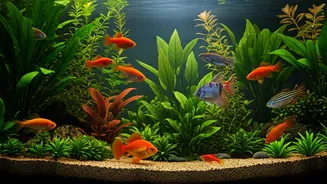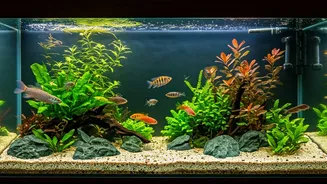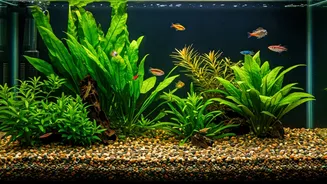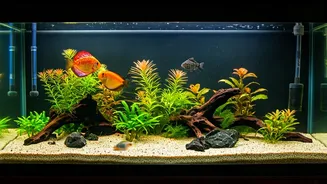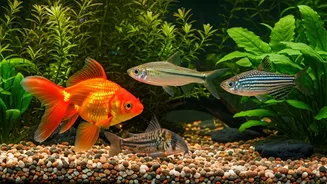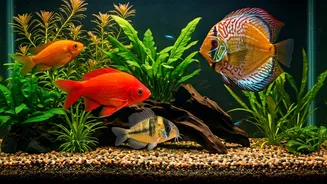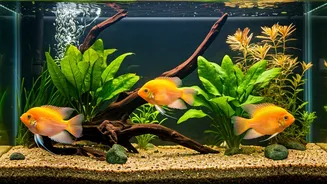Introduction to Aquariums
Embarking on the journey of owning an aquarium can be a rewarding experience, providing a calming and beautiful element to any home. However, choosing
the right fish is crucial for success and enjoyment. Selecting low-maintenance species is particularly important for beginners. Easy-to-care-for fish allow you to understand the fundamentals of aquarium upkeep without being overwhelmed. These fish typically have fewer specialized needs regarding water parameters, diet, and tank size. This foundational knowledge is key, setting the stage for more complex aquatic hobbies later. They help in forming good habits for water quality, feeding, and tank maintenance. In this guide, we'll explore ten of the best fish species known for their resilience and beginner-friendliness, ensuring a positive start for any new aquarist.
The Humble Betta
Betta fish, also known as Siamese fighting fish, are popular choices due to their vibrant colors and relatively low maintenance. They are labyrinth fish, meaning they can breathe air from the surface, which is beneficial in less-oxygenated environments. A small tank of at least 5 gallons is generally suitable for a single Betta. These fish prefer warm water, typically between 76°F and 82°F (24°C and 28°C), and benefit from a well-filtered environment. While they can be housed with other peaceful species in larger tanks, male Bettas must be kept separately due to their aggressive nature. They thrive on a diet of high-quality betta pellets, supplemented occasionally with bloodworms or brine shrimp. Regular partial water changes (about 25% weekly) are essential to maintain water quality and keep your Betta healthy and happy.
Cheerful Guppies
Guppies are another excellent choice for beginners because of their resilience and adaptability. These livebearers are known for their lively movements and prolific breeding capabilities. A 10-gallon tank can comfortably house a small group of guppies. These fish are happy in water temperatures ranging from 72°F to 82°F (22°C to 28°C) and are relatively tolerant of fluctuating water conditions. Guppies are omnivores, readily accepting a variety of foods, including flakes, pellets, and live or frozen treats. It's important to monitor their breeding habits, as guppies can quickly overpopulate a tank. Providing hiding places, such as plants or decorations, can help to control the population and give the fry (baby guppies) a chance to survive. Regular maintenance, including water changes and gravel vacuuming, is crucial for their well-being.
Peaceful Neon Tetras
Neon Tetras are an incredibly popular choice, loved for their bright colors and peaceful demeanor. These small, schooling fish look great in groups of six or more in a well-planted aquarium. A minimum tank size of 10 gallons is recommended for a school of Neon Tetras. They thrive in water temperatures between 72°F and 78°F (22°C and 26°C), with slightly acidic water conditions (pH 6.0-7.0) being ideal. They are susceptible to certain diseases, so maintaining good water quality is vital. Neon Tetras are primarily carnivores, and a diet of small, high-quality flake food supplemented with brine shrimp or daphnia is beneficial. Regular water changes and a well-established filtration system help prevent common fish ailments and maintain the vibrant color of these striking little fish.
Hardy Corydoras Catfish
Corydoras catfish, often called Corys, are excellent bottom dwellers that complement almost any community tank. These peaceful fish are known for their unique behavior, constantly sifting through the substrate for food. Various species exist, but most stay small and can thrive in a tank of 10 gallons or more. Corydoras prefer water temperatures between 72°F and 82°F (22°C and 28°C) and like a sandy substrate to protect their barbels. They are omnivores, accepting sinking pellets, flakes, and occasional treats of bloodworms or brine shrimp. They help keep the tank clean by eating leftover food and detritus, contributing to the overall health of the aquarium. Make sure to provide plenty of hiding spots for them, such as plants or driftwood, to make them feel safe and comfortable.
The Resilient Zebra Danio
Zebra Danios are incredibly active and hardy fish, known for their zebra-like stripes and playful behavior. These fish are ideal for beginners because they can tolerate a wide range of water conditions. A 10-gallon tank can comfortably house a small school. They are happy in temperatures between 64°F and 74°F (18°C and 24°C) and are not very particular about water chemistry. Zebra Danios are omnivores, readily eating flake food, pellets, and small live or frozen foods. They are also known for their jumping abilities, so it's essential to have a secure lid on the aquarium. Their hardiness and active nature make them an engaging addition to any beginner's aquarium, providing constant movement and interest.
Placid White Cloud
White Cloud Mountain Minnows are another hardy and easy-to-care-for fish. They are very similar to Zebra Danios in terms of their hardiness and ability to tolerate temperature fluctuations. These fish are schooling fish that prefer cooler temperatures, ranging from 60°F to 72°F (16°C to 22°C), making them suitable for unheated aquariums in many climates. A 10-gallon tank can comfortably house a small group. They are omnivores, accepting flakes, pellets, and small live or frozen foods. White Cloud Mountain Minnows are known for their peaceful temperament, making them suitable tankmates for other small, non-aggressive species. Their low-maintenance needs make them a fantastic option for beginners, offering a beautiful and resilient addition to your aquarium.
Charming Cherry Shrimp
Cherry Shrimp provide a unique and rewarding experience. These small invertebrates can significantly contribute to the health of the aquarium. They are scavengers that eat algae and leftover food. A small, well-planted tank of 5 gallons or more is suitable for a colony. Cherry Shrimp are relatively easy to care for, requiring water temperatures between 65°F and 80°F (18°C and 27°C). They thrive in water with a stable pH level. They are very sensitive to copper, so it’s essential to avoid copper-containing medications or food. They eat algae, biofilm, and other organic matter in the aquarium. Cherry Shrimp are a fascinating addition to a community tank, providing beneficial cleaning services and adding a touch of color.
The Mysterious Mystery Snail
Mystery Snails add a touch of elegance and functionality to the aquarium. These snails can grow quite large and are effective algae eaters, contributing to a clean and healthy environment. A 10-gallon tank is often the minimum recommended size for a Mystery Snail. They prefer water temperatures between 68°F and 84°F (20°C and 29°C) and a pH of 7.0-8.0. It is crucial to provide a calcium-rich diet to ensure their shells stay healthy. They primarily eat algae and leftover food, and can be given algae wafers and other foods. They are generally peaceful and can coexist with many other species, making them ideal companions. Ensure the tank is well-covered, as they sometimes escape.
Setting up your Aquarium
To create a thriving aquatic environment, start with a properly sized and cycled aquarium. Choose a tank size based on the number and size of fish you plan to keep. Cycling is a crucial process, creating beneficial bacteria that break down harmful ammonia and nitrites. This takes several weeks, and during this time, you may need to add a small amount of fish food to kickstart the process. Select a filter that is appropriate for the tank size, and be sure to use an aquarium heater to maintain the ideal temperature for the fish. Decorate your tank with gravel or sand, plants, and decorations to provide hiding places and enrich the environment. The water should be dechlorinated, and regular partial water changes are essential to maintain water quality. Consistent maintenance and a well-planned setup lay the foundation for a beautiful and flourishing aquarium.


